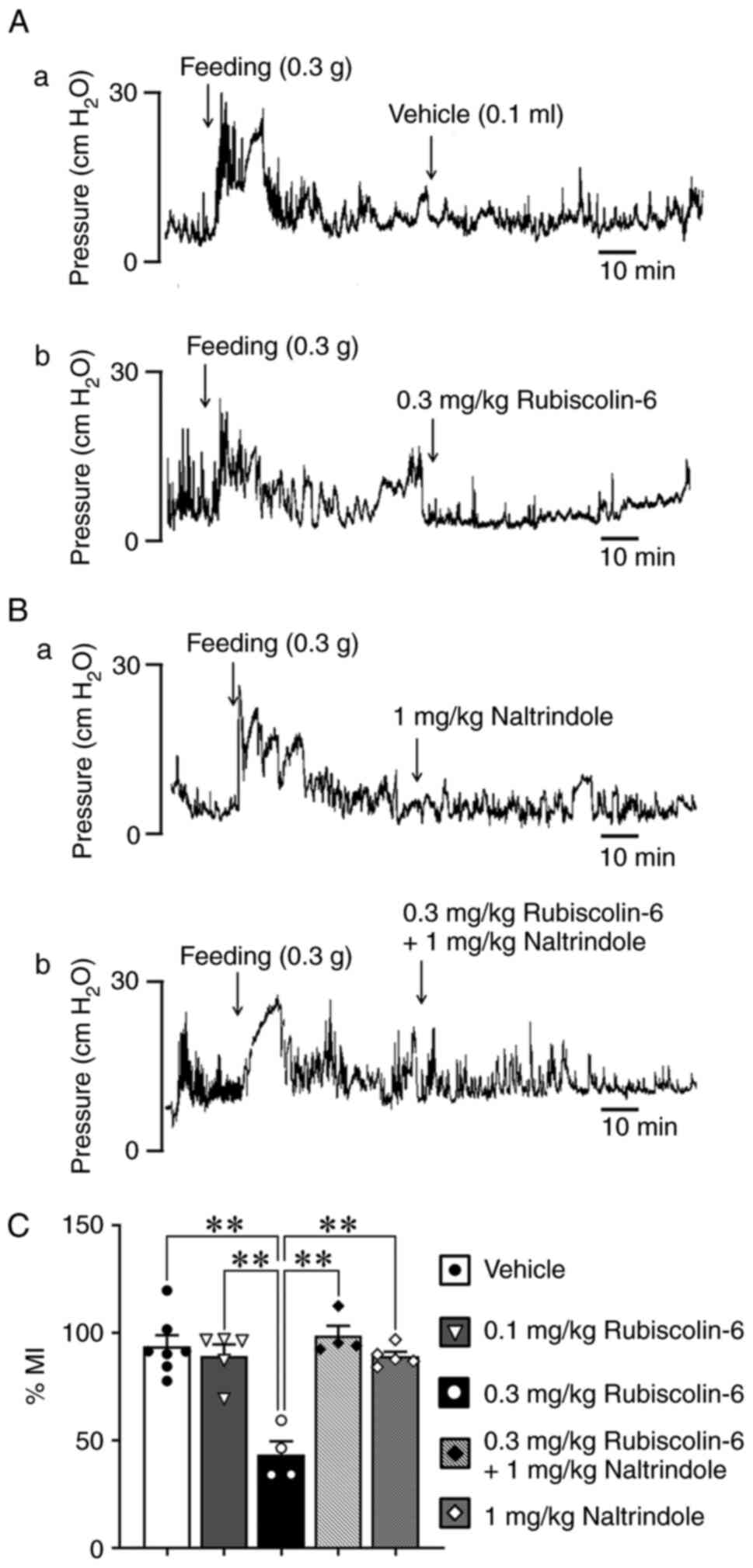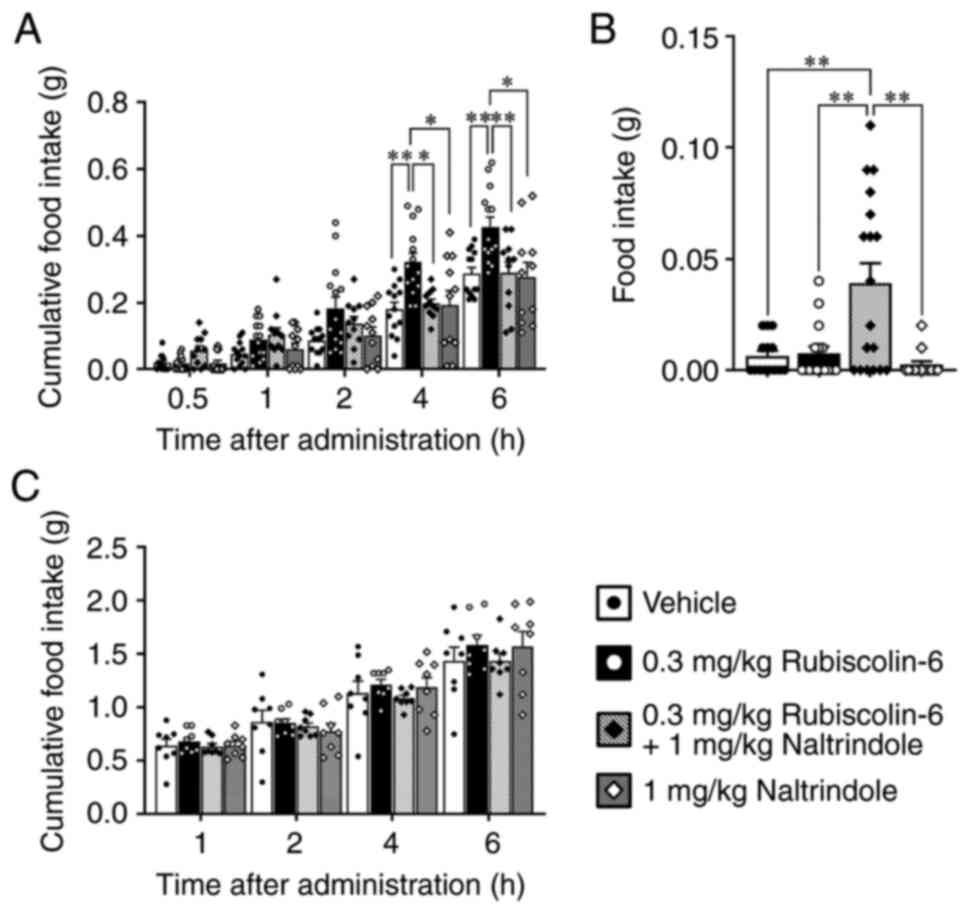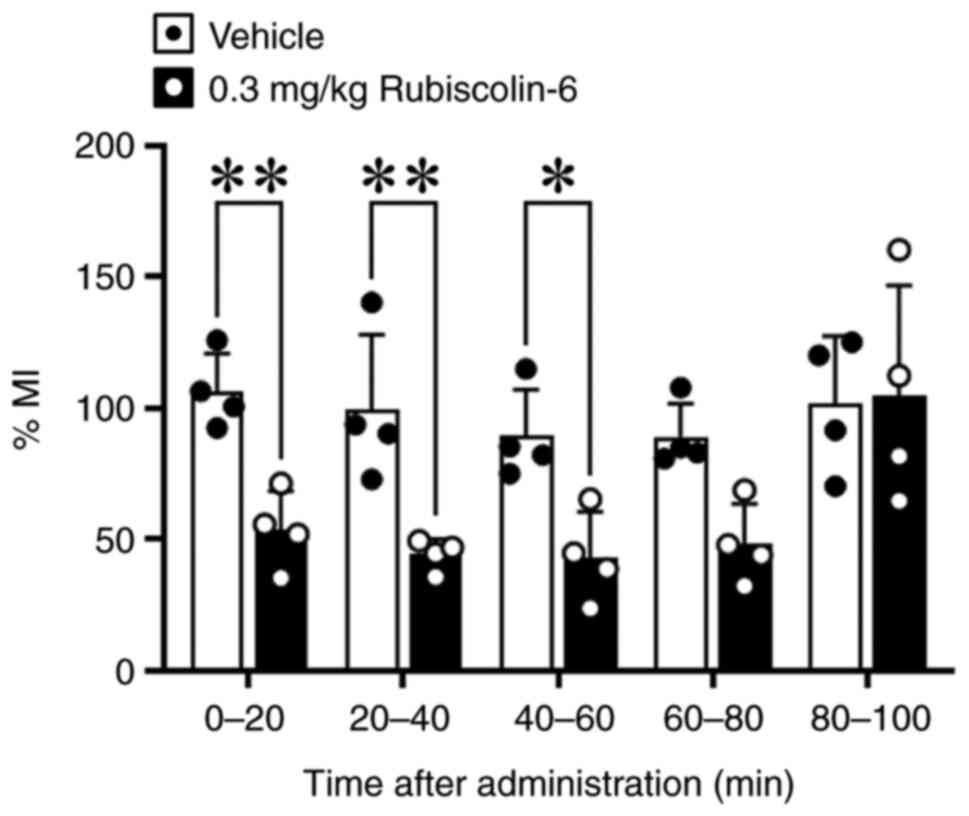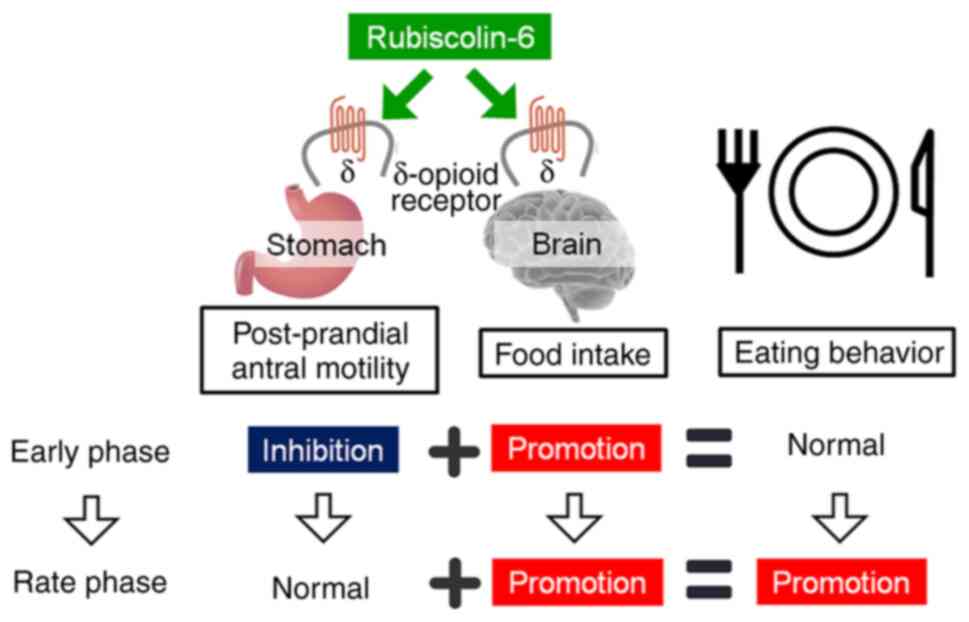|
1
|
Chakrabarti S, Guha S and Majumder K:
Food-derived bioactive peptides in human health: Challenges and
opportunities. Nutrients. 10:17382018. View Article : Google Scholar : PubMed/NCBI
|
|
2
|
Tyagi A, Daliri EBM, Ofosu FK, Yeon SJ and
Oh DH: Food-derived opioid peptides in human health: A review. Int
J Mol Sci. 21:88252020. View Article : Google Scholar : PubMed/NCBI
|
|
3
|
Yang S, Yunden J, Sonoda S, Doyama N,
Lipkowski AW, Kawamura Y and Yoshikawa M: Rubiscolin, a delta
selective opioid peptide derived from plant Rubisco. FEBS Lett.
509:213–217. 2001. View Article : Google Scholar : PubMed/NCBI
|
|
4
|
Bar-On YM and Milo R: The global mass and
average rate of rubisco. Proc Natl Acad Sci USA. 116:4738–4743.
2019. View Article : Google Scholar : PubMed/NCBI
|
|
5
|
Ellis RJ: The most abundant protein in the
world. Trends Biochem Sci. 4:241–244. 1979. View Article : Google Scholar
|
|
6
|
Yang S, Kawamura Y and Yoshikawa M: Effect
of rubiscolin, a opioid peptide derived from Rubisco, on memory
consolidation. Peptides. 24:325–328. 2003. View Article : Google Scholar : PubMed/NCBI
|
|
7
|
Hirata H, Sonoda S, Agui S, Yoshida M,
Ohinata K and Yoshikawa M: Rubiscolin-6, a delta opioid peptide
derived from spinach Rubisco, has anxiolytic effect via activating
sigma1 and dopamine D1 receptors. Peptides. 28:1998–2003. 2007.
View Article : Google Scholar : PubMed/NCBI
|
|
8
|
Mitsumoto Y, Sato R, Tagawa N and Kato I:
Rubiscolin-6, a δ-opioid peptide from spinach RuBisCO, exerts
antidepressant-like effect in restraint-stressed mice. J Nutr Sci
Vitaminol (Tokyo). 65:202–204. 2019. View Article : Google Scholar : PubMed/NCBI
|
|
9
|
Kaneko K, Lazarus M, Miyamoto C, Oishi Y,
Nagata N, Yang S, Yoshikawa M, Aritake K, Furuyashiki T, Narumiya
S, et al: Orally administered rubiscolin-6, a δ opioid peptide
derived from Rubisco, stimulates food intake via leptomeningeal
lipocallin-type prostaglandin D synthase in mice. Mol Nutr Food
Res. 56:1315–1323. 2012. View Article : Google Scholar : PubMed/NCBI
|
|
10
|
Kaneko K, Mizushige T, Miyazaki Y, Lazarus
M, Urade Y, Yoshikawa M, Kanamoto R and Ohinata K: δ-Opioid
receptor activation stimulates normal diet intake but conversely
suppresses high-fat diet intake in mice. Am J Physiol Regul Integr
Comp Physiol. 306:R265–R272. 2014. View Article : Google Scholar : PubMed/NCBI
|
|
11
|
Gosnell BA, Levine AS and Morley JE: The
stimulation of food intake by selective agonists of mu, kappa and
delta opioid receptors. Life Sci. 38:1081–1088. 1986. View Article : Google Scholar : PubMed/NCBI
|
|
12
|
Sudakov SK, Nazarova GA and Alekseeva EV:
Changes in feeding behavior, locomotor activity, and metabolism in
rats upon modulation of opioid receptors in the gastrointestinal
tract. Bull Exp Biol Med. 156:423–425. 2014. View Article : Google Scholar : PubMed/NCBI
|
|
13
|
Ruckebusch Y, Bardon T and Pairet M:
Opioid control of the ruminant stomach motility: Functional
importance of mu, kappa and delta receptors. Life Sci.
35:1731–1738. 1984. View Article : Google Scholar : PubMed/NCBI
|
|
14
|
Okamoto T, Kurahashi K and Fujiwara M:
Effects of naloxone and opioid agonists on gastric excitatory
responses to stimulation of the vagus nerve in cats. Br J
Pharmacol. 95:329–334. 1988. View Article : Google Scholar : PubMed/NCBI
|
|
15
|
Ketwaroo GA, Cheng V and Lembo A:
Opioid-induced bowel dysfunction. Curr Gastroenterol Rep.
15:3442013. View Article : Google Scholar : PubMed/NCBI
|
|
16
|
Camilleri M: Peripheral mechanisms in
appetite regulation. Gastroenterology. 148:1219–1233. 2015.
View Article : Google Scholar : PubMed/NCBI
|
|
17
|
Janssen P, Berghe PV, Verschueren S,
Lehmann A, Depoortere I and Tack J: Review article: The role of
gastric motility in the control of food intake. Aliment Pharmacol
Ther. 33:880–894. 2011. View Article : Google Scholar : PubMed/NCBI
|
|
18
|
Sturm K, Parker B, Wishart J,
Feinle-Bisset C, Jones KL, Chapman I and Horowitz M: Energy intake
and appetite are related to antral area in healthy young and older
subjects. Am J Clin Nutr. 80:656–667. 2004. View Article : Google Scholar : PubMed/NCBI
|
|
19
|
Kojima M, Hosoda H, Date Y, Nakazato M,
Matsuo H and Kangawa K: Ghrelin is a growth-hormone-releasing
acylated peptide from stomach. Nature. 402:656–660. 1999.
View Article : Google Scholar : PubMed/NCBI
|
|
20
|
Fujino K, Inui A, Asakawa A, Kihara N,
Fujimura M and Fujimiya M: Ghrelin induces fasted motor activity of
the gastrointestinal tract in conscious fed rats. J Physiol.
550:227–240. 2003. View Article : Google Scholar : PubMed/NCBI
|
|
21
|
Chen CY, Inui A, Asakawa A, Fujino K, Kato
I, Chen CC, Ueno N and Fujimiya M: Des-acyl ghrelin acts by CRF
type 2 receptors to disrupt fasted stomach motility in conscious
rats. Gastroenterology. 129:8–25. 2005. View Article : Google Scholar : PubMed/NCBI
|
|
22
|
Asakawa A, Inui A, Kaga T, Yuzuriha H,
Nagata T, Ueno N, Makino S, Fujimiya M, Niijima A, Fujino MA and
Kasuga M: Ghrelin is an appetite-stimulatory signal from stomach
with structural resemblance to motilin. Gastroenterology.
120:337–345. 2001. View Article : Google Scholar : PubMed/NCBI
|
|
23
|
Kairupan TS, Cheng KC, Asakawa A, Amitani
H, Yagi T, Ataka K, Rokot NT, Kapantow NH, Kato I and Inui A:
Rubiscolin-6 activates opioid receptors to enhance glucose uptake
in skeletal muscle. J Food Drug Anal. 27:266–274. 2019. View Article : Google Scholar : PubMed/NCBI
|
|
24
|
Tanaka R, Inui A, Asakawa A, Atsuchi K,
Ataka K and Fujimiya M: New method of manometric measurement of
gastroduodenal motility in conscious mice: Effects of ghrelin and
Y2 depletion. Am J Physiol Gastrointest Liver Physiol.
297:G1028–G1234. 2009. View Article : Google Scholar : PubMed/NCBI
|
|
25
|
Kawai S, Takagi Y, Kaneko S and Kurosawa
T: Effect of three types of mixed anesthetic agents alternate to
ketamine in mice. Exp Anim. 60:481–487. 2011. View Article : Google Scholar : PubMed/NCBI
|
|
26
|
Blignaut CJ, Steenkamp G, Loock D, Emslie
R and Zeiler GE: Immobilization, cardiopulmonary and blood gas
effects of ketamine-butorphanol-medetomidine versus
butorphanol-midazolam-medetomidine in free-ranging serval
(Leptailurus serval). Vet Anaesth Analg. 48:707–715. 2021.
View Article : Google Scholar : PubMed/NCBI
|
|
27
|
Eggers B, Tordiffe ASW, Lamberski N,
Lawrenz A, Sliwa A, Wilson B and Meyer LCR: EVALUATION OF TWO DOSES
OF BUTORPHANOL-MEDETOMIDINE-MIDAZOLAM FOR THE IMMOBILIZATION OF
WILD VERSUS CAPTIVE BLACK-FOOTED CATS (FELIS NIGRIPES). J Zoo Wildl
Med. 51:497–506. 2020. View Article : Google Scholar : PubMed/NCBI
|
|
28
|
Verstegen J and Petcho A:
Medetomidine-butorphanol-midazolam for anaesthesia in dogs and its
reversal by atipamezole. Vet Rec. 132:353–357. 1993. View Article : Google Scholar : PubMed/NCBI
|
|
29
|
Holzer P: Opioid receptors in the
gastrointestinal tract. Regul Pept. 155:11–17. 2009. View Article : Google Scholar : PubMed/NCBI
|
|
30
|
Holle GE and Steinbach E: Different
endogenous opioid effects on delta- and mu-receptor subtypes in
antral and duodenal motility of conscious dogs. Dig Dis Sci.
47:1027–1033. 2002. View Article : Google Scholar : PubMed/NCBI
|
|
31
|
Porreca F, Mosberg HI, Hurst R, Hruby VJ
and Burks TF: Roles of mu, delta and kappa opioid receptors in
spinal and supraspinal mediation of gastrointestinal transit
effects and hot-plate analgesia in the mouse. J Pharmacol Exp Ther.
230:341–348. 1984.PubMed/NCBI
|
|
32
|
Galligan JJ, Mosberg HI, Hurst R, Hruby VJ
and Burks TF: Cerebral delta opioid receptors mediate analgesia but
not the intestinal motility effects of intracerebroventricularly
administered opioids. J Pharmacol Exp Ther. 229:641–648.
1984.PubMed/NCBI
|
|
33
|
Poole DP, Pelayo JC, Scherrer G, Evans CJ,
Kieffer BL and Bunnett NW: Localization and regulation of
fluorescently labeled delta opioid receptor, expressed in enteric
neurons of mice. Gastroenterology. 141:982–991. 2011. View Article : Google Scholar : PubMed/NCBI
|
|
34
|
Wittert G, Hope P and Pyle D: Tissue
distribution of opioid receptor gene expression in the rat. Biochem
Biophys Res Commun. 218:877–881. 1996. View Article : Google Scholar : PubMed/NCBI
|
|
35
|
Schwartz MW, Woods SC, Porte D Jr, Seeley
RJ and Baskin DG: Central nervous system control of food intake.
Nature. 404:661–671. 2000. View
Article : Google Scholar : PubMed/NCBI
|
|
36
|
Israel Y, Kandov Y, Khaimova E, Kest A,
Lewis SR, Pasternak GW, Pan YX, Rossi GC and Bodnar RJ: NPY-induced
feeding: Pharmacological characterization using selective opioid
antagonists and antisense probes in rats. Peptides. 26:1167–1175.
2005. View Article : Google Scholar : PubMed/NCBI
|
|
37
|
Mercer RE, Chee MJ and Colmers WF: The
role of NPY in hypothalamic mediated food intake. Front
Neuroendocrinol. 32:398–415. 2011. View Article : Google Scholar : PubMed/NCBI
|


















